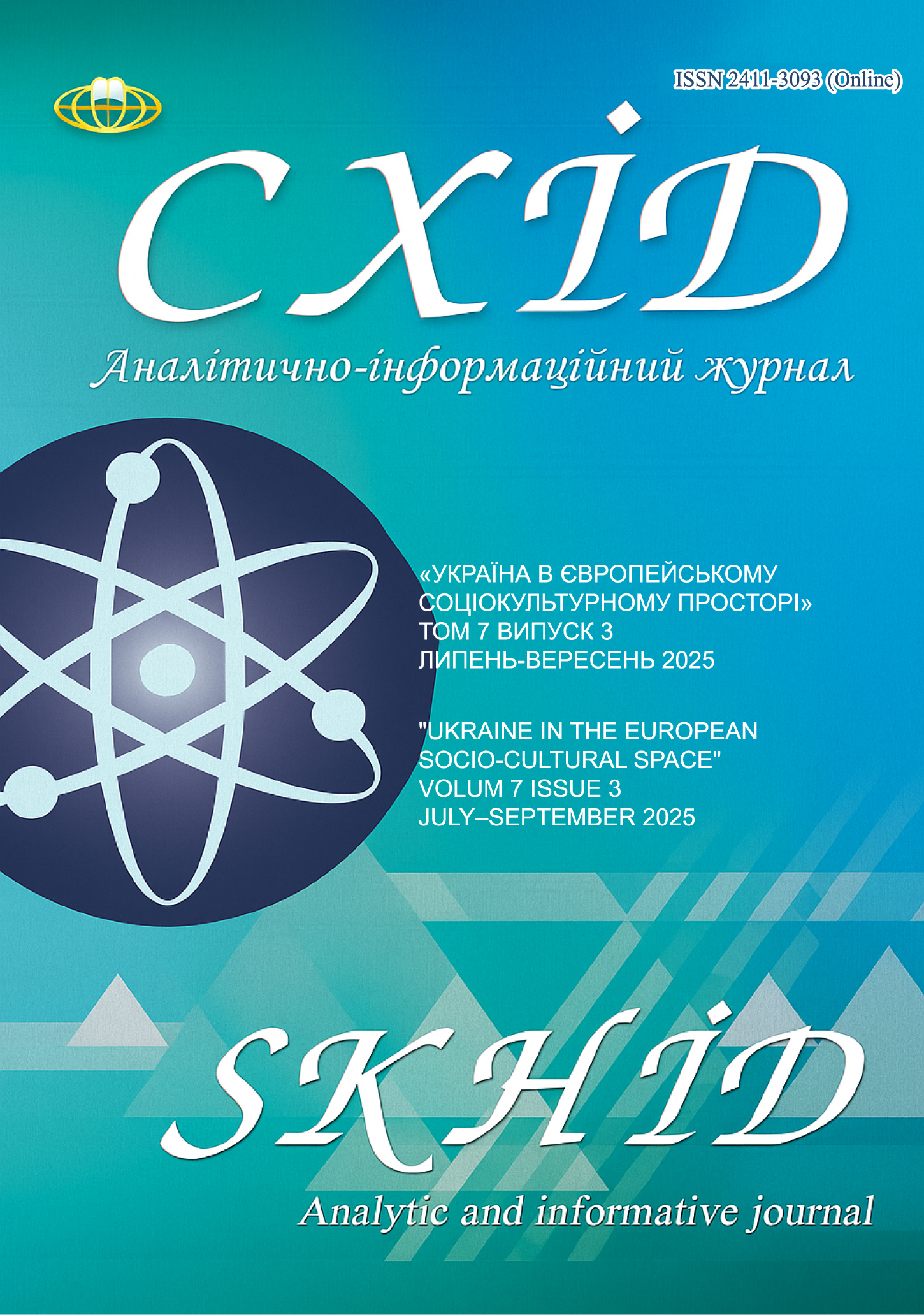The Development of Philosophical Thought in the Greek Colonies on the Territory of Ukraine (the Case of Olbia)
DOI:
https://doi.org/10.21847/2411-3093.2025.732Keywords:
philosophy in Ukraine, Ukrainian studies paradigm, Olbia, Miletus, Orphism, Pythagoreanism, HellenismAbstract
The article is devoted to analysing the role of ancient Greek thinkers in the history of Ukrainian philosophy. Ukrainian philosophical thought, like all Ukrainian culture, is based on two fundamental sources: ancient cosmism and the Christian belief in the immortality of the soul. This makes Ukrainian philosophy part of the pan-European tradition. The search for European roots leads to the need to study the philosophical views of the population of ancient Greek colonies in the territory of modern Ukraine. Taking into account the temporarily occupied territories of Ukraine, the emphasis is placed on the largest of the Greek colonies available today – Olbia, the ruins of which are located near the village of Parutino in the Mykolaiv region. The article is written within the framework of the interdisciplinary methodology of the Ukrainian studies paradigm and takes into account the results of research in classical ancient literature (Herodotus, Diogenes Laertius, Dion Chrysostom, Ovid), prosopographic, epigraphic and archaeological discoveries. The first colonists in Olbia were citizens of Miletus, a city in Ionia with a world-famous philosophical school. It is hypothesised that the Olbiopolitans were familiar with the natural philosophical views of the metropolis: Thales, Anaximander, Anaximenes. This is indirectly indicated by the prevalence of graffiti with the name Anaximander in Olbia. Researchers have discovered bone plates with inscriptions such as “Life-Death-Life-Truth”, “Peace-War”, “Truth-Deception”, “Body-Soul”, “Dionysus-Orphics” testify to the popularity among the Olbiopolitans of ideas of Orphism and Pythagoreanism about the immortality of the human soul, the possibility of resurrection of the dead and “eternal return”. In the Hellenistic period, Dion Chrysostom wrote in his “Oratio Borysthenitica” about the philosophical conservatism of the Olbiopolitans, who loved Homer, although they were also familiar with the views of Plato. It is emphasised that Greek philosophy spread among the barbarian population of the Northern Black Sea region through Olbia and other colonies. The conclusion is made about the connection between ancient cosmism through Neoplatonism and early Christian ideas about the world, God, and man, which became decisive for the later Ukrainian philosophical tradition.
Downloads
References
Buiskikh A., Ivchenko, A. (2023). New Findings in Scythian Animal Style from Olbia Pontica. Pontica. Is. 56, Sup.X.
Diogenes Laërtius (2013). Lives of Eminent Philosophers, edited by Tiziano Dorandi, Cambridge.
Dio Chrysostom (1932). Τhe thirty-sixth. Οr Borysthenitic, Dicourse, which Dio Delivered in his Native Land. Dio Chrysostom, with an English translation by J.W. Cohoon. London W. Heinemann. Vol. 3.
Dodonov, R. (2024). The Antique Sources of Ukrainian Philosophy: The Philosophical Views of the Olbiopol-itans – Literary, Epigraphic, and Archaeological Data. International Scientific Conference “The Archaeological Work in the Greek Settlements of the Black Sea and their Environs during the Last Decade”. Abstracts arranged alphabetically by author (Alexandroupolis, 28–30 May 2024). https://bs2024.bscc.duth.gr/wp-content/uploads/2024/04/01.-Alphabetical_Email_Participants.pdf
Ebo, S. (2018). Restoring the African origins of philosophy. Skhid. 5(157): 10-11. https://doi.org/10.21847/1728-9343.2018.5(157).148338
Gavrylyuk, N. A. (2021). Sea Area (the Case of the Twin Cities of Borysthenes-Olbia). Environment and Habi-tation around the Ancient Black Sea. Walter de Gruy-ter GmbH & Co KG. 269 р.
Herodotus; Blanco, Walter (2013). The Histories. New York, W.W. Norton & Company.
Kinstrandt, J.F. (1976). Bion of Borysthenes: A Collection of the Fragments. Uppsala: Almqvist & Wiksell International, Stockholm.
Kraliuk, P.M. (2015). Istoriia filosofii Ukrainy. Kyiv, KNT.
Kryzhytskyi, S.D.; Krapivina, V.V.; Leipunska, N.O. (1994). Holovny etapy istorychnoho rozvytku Olvii. Arkheolohiia. № 2.
Nykolaev, N.Y. (2014). Prosopohrafyia Olvyy Pontyiskoi
V v. do n.е. – I v. n.е. Kyіv.
Ostroverkhov, A.S. (1994). Animal Style in Culture of Olbia. Arkheolohiia. No 2.
Petropoulos, E.K. (2005). Hellenic Colonization in Euxeinos Pontos. Penetration, Early Establishment and the Problem of the “Emporion” Revisited. Oxford.
Podosynov, A.V. (2012). Svedenyia Dyona Khrysostoma o varvaryzatsyy Olvyy v I v. n.e. i dannye arkheolohyy i epyhrafyky. Arystei: Vestnyk klassycheskoi fylolohyy y antychnoi istoryy. No 6: 157-187.
Rusiaeva, A.S. (1994). Olbian Democracy. Arkheolohiia. No 2.
Skrzhytskaia, M.V. (2014). Obrazovanye y dosuh v antychnykh hosudarstvakh Severnoho Prychernomoria. Kyiv. S. 10.
Yailenko, V.P. (2017). Istoryia i epyhrafeka Olvii, Khersonesa i Bospora VII v. do n.e. – VII v. n.e. SPb, Nestor-Ystoryia.
Zubar, V.M.; Son, N.A. (2007). Severo-Zapadnoe Prychernomore v antychnuiu epokhu. Symferopol.
Downloads
Published
How to Cite
Issue
Section
License
Copyright (c) 2025 Роман Додонов

This work is licensed under a Creative Commons Attribution-NonCommercial-NoDerivatives 4.0 International License.
1. Authors bear responsibility for the accuracy of facts, quotations, numbers and names used.
2. Manuscripts are not sent back.
3. The publisher does not always agree with the authors' opinion.
4. The authors reserve the right to authorship of the work and pass the first publication right of this work to the journal under the terms of a Creative Commons Attribution-NonCommercial-NoDerivatives 4.0 International License. This license allows others to distribute (copy) the published work for non-commercial purposes, provided there is mandatory attribution to its authors and a link to the first publication in our journal.
5. The authors have the right to conclude separate supplement agreements that relate to non-exclusive work distribution in the form in which it has been published by the journal (for example, to upload the work to the online storage of the journal or publish it as part of a monograph), provided that the reference to the first publication of the work in this journal is included.

